My Thai-language tutor and good friend, Vinny, kept badgering me to spend a weekend at his boyhood home and parents’ rice farm, about a three-hour journey from our university town. He wanted me to experience rice farming close up and personal. Finally, with a weekend free coming up, I gave him a call, and off we went in his pickup truck to see life unlike my university environment.
Vinny is really a great guy: father of two older kids (high school and university students), husband of one wife, fish farmer, rice farmer, motorbike repairman, dormitory owner/manager, chili-plant grower, and anything else he can put his hand to in order to make a few extra baht to keep the family in food and clothes. With all that activity, he still finds time to befriend this farang—language lessons as often as I want, and an open door to do short tours around Isan in his pickup truck.
Vinny personifies the Thai idiom “naam-jai” (literally “water-heart”), meaning someone who is totally generous with no strings attached. My Thai friend sometimes stops by my little duplex to chat, and we go on for hours. He’s had such an interesting life—growing up near an American military base during the Vietnam war, working abroad in Saudi Arabia and Iraq. He goes on how the Americans were so kind and helpful to his boyhood village. In some way, I think he’s paying back their kindness by being so kind and generous to me.
Leaving shortly after dawn on a Saturday morning, Vinny took on the role of a local tour guide—full of stories and history of the area. Here’s a string of snapshots of some of our temporary stops along the way which took the full day.
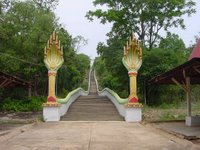
A long one-kilometer climb to the
top of a sacred Buddhist mountain.
In the steamy climate, and halfway
to the top of the mountain, this
position looks rather inviting.
to the top of the mountain, this
position looks rather inviting.
An overweight Buddha image
reminds me why I’m panting and
sweating so much on the climb.
reminds me why I’m panting and
sweating so much on the climb.
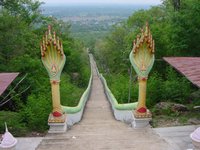
View from the top.
A former US bomb casing
converted into a temple bell,
now calls worshippers to meditation.
converted into a temple bell,
now calls worshippers to meditation.
An artisan putting final touches
on an ornate temple altar.
on an ornate temple altar.

You donate 3,000 baht (about
$75 US), and you get your name
on a fence section at the temple.
Thais have a quirky sense of humor when out in the forest.
Whenever they see a big overhanging rock, they love
to put sticks and objects under it as if the spindly little
struts were supporting it.
The small red lettering on the rock?
Temple notice: “Do not support this stone!”
Whenever they see a big overhanging rock, they love
to put sticks and objects under it as if the spindly little
struts were supporting it.
The small red lettering on the rock?
Temple notice: “Do not support this stone!”
This is one “stick” no one grabs to
support their forest stones.
It’s really an insect.
support their forest stones.
It’s really an insect.
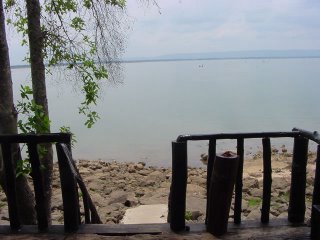
We came upon quite a large reservoir which the
local population finds many uses for.
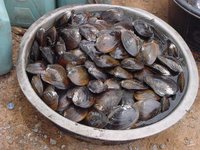

Top: Freshwater clams at a nearby market.
Bottom: Freshwater shrimp from the barby anyone?
I'm suprised at how many "seafoods" have their
freshwater counterparts: mussels, crabs, etc.

Quite a beautiful national park
lined the shores of the reservoir.
Park visitors’ headquarters. Thai
national parks are well
organized and inviting places to visit.
national parks are well
organized and inviting places to visit.
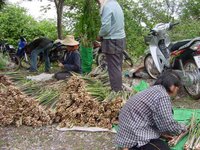
Asparagus vendors spreading their
veggies on the road shoulder.
This veggie is plentiful and cheap.

Herbal hawker selling his remedies.
Looked like weeds to me…
Tomb of a famous local monk.
Those elephants are life-sized!
Those elephants are life-sized!
So far, being a rice farmer seemed like a pretty cushy job--riding around in a pickup all day, enjoying the local sites with my personal interpreter and tour guide, savoring the local delicacies, taking snapshots like any other tourist. Loved it!
To be continued....
See post December 27, 2005



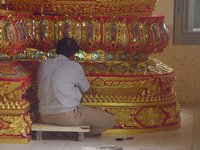

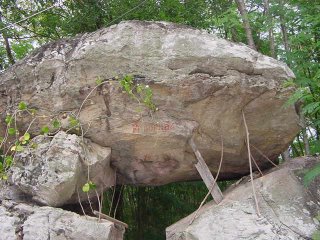
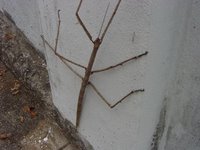





I have always believe there is more to Thailand than just Krungthep! Life in 'tang jangwat' is so different from the capital city!
ReplyDeleteVery nice blog! You can be a perfect writer for travel guid book. Really.
ReplyDeleteBeautiful pictures. And you friend must have been real nice person to think of it and take you through all of these nice places.
ReplyDeleteGreat post.. its good to have good friends !!
ReplyDeleteWhere is this beautiful place and how to get there, thanks.
ReplyDeleteHi JD,
ReplyDeleteอุทยาน park
แทำงชาติ
ภูเก๊า
Where is this place?
Regards,
About 50 kilometers northwest of Khon Kaen, this national park sits on the northwest shores of the huge reservoir created by Ubol Rat Dam. Directions: Take national highway 2 north from Khon Kaen for 34 km. At the junction of highways 2 and 2109, take the latter highway northwest until you reach the dam and reservoir. From there, follow all signs to Phu Kao-Phu Phankham National Park.
ReplyDeletePlease write something, no?
ReplyDeleteMaybe post a picture looking out of your house window?
It's called "writer's block," Trangam. And I only get it about once a month (duration: 29-30 days). :|
ReplyDeleteNevertheless, your last comment is a profound encouragement to me! I will try to crank out part 2 before the New Year! (my goal!)
Ted: Right-click on the map, click "properties" and follow the address. It's fun doing the input to create a map, and yes, I'd like to see your travels!
ReplyDelete